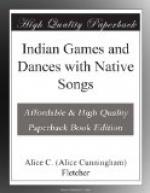The players on the two sides are chosen in the following manner: The person who is to act as Umpire and to perform the opening ceremony must sit in a circle drawn on the ground, about six feet in diameter, and face either the North or the South. All the sticks are placed before him in a bunch. He is then blindfolded. After that he picks up a stick with each hand and lays down the stick that he has in his right hand on his left side, the stick that he has in his left hand he lays down on his right side. When he has finished dividing the sticks in this manner they are in two bunches, one toward the East and the other toward the West. The blindfold is then removed. When that is done, all the players run to the two heaps and each takes his own stick, recognizing it by the design marked or cut upon the stick. All those whose sticks were in the pile to the East must tie on a badge or streamer the color of the East, red. All those whose sticks were in the bunch toward the West must tie on the color of the West, yellow.
All the players must now stand in two lines. One line starts from the circle and extends directly toward the goal at the East; all in this line must be only those whose sticks were in the east pile and who have on the color of the East, red. The other line starts from the circle and stretches out toward the west goal, and is composed of those whose sticks were in the west pile and who have on the color of the West, yellow. The four Guardians of the Path take their places. The Umpire wears no color. All being in readiness, the Umpire advances to the middle of the circle.
THE OPENING CEREMONY
The Umpire places the ball in the exact center of the circle, then he gently urges it with his stick in a line toward the North until it reaches the edge of the circle. There he picks it up and puts it back in the center of the circle. Again he gently pushes it with his stick along a line toward the South until the edge of the circle is reached, when he returns the ball to the center of the circle with his hand. In the same manner as before he sends the ball slowly along a line to the West. When the edge of the circle is reached he picks up the ball and returns it to the center. Once more the ball is moved in a line, this time to the East; when it touches the line of the circle it is picked up as before and placed in the center of the circle. The symbolic figure that has thus been made is that of a circle within which two straight lines cross each other at right angles; the circle is divided into four quarters, one for each of the Four Winds.
THE GAME
Every player now stands at attention, with his stick ready for action. The Umpire pauses a moment at the center of the circle, then he picks up the ball lying there and throws it into the air as high as he can. All the players, who have watched the throw, run in the direction where the ball seems likely to descend, in order to have a chance to strike it toward one of the goals.




